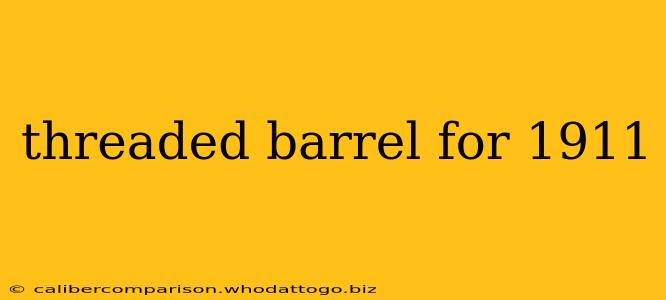The 1911 platform, a timeless classic in the world of handguns, offers unparalleled customization options. One popular modification is adding a threaded barrel, opening up a world of possibilities for accessories like suppressors and flash hiders. This guide dives deep into everything you need to know about choosing and installing a threaded barrel for your 1911.
Understanding the Benefits of a Threaded 1911 Barrel
A threaded barrel significantly enhances the 1911's versatility. Here's why many shooters opt for this modification:
-
Suppressor Integration: This is the primary reason many choose a threaded barrel. A suppressor significantly reduces the sound and flash of gunfire, enhancing shooting comfort and hearing protection. This is particularly beneficial for competition shooting, training, and hunting.
-
Flash Hider Attachment: Flash hiders mitigate the muzzle flash, improving visibility in low-light conditions and reducing the shooter's signature. They can also contribute to recoil reduction in some cases.
-
Compensator Installation: Compensators redirect propellant gases to mitigate recoil and muzzle rise, improving accuracy and follow-up shots.
-
Enhanced Customization: A threaded barrel simply allows for a wider range of accessories, giving you more control over your firearm's performance and aesthetics.
Choosing the Right Threaded Barrel for Your 1911
Selecting the appropriate threaded barrel requires careful consideration of several factors:
1. Caliber:
Ensure the barrel's caliber matches your 1911's (e.g., .45 ACP, 9mm, .38 Super). Using an incompatible barrel can lead to serious malfunctions and damage.
2. Thread Pitch:
The thread pitch (measured in threads per inch or TPI) is crucial. Common thread pitches for 1911s include 1/2x28 and 9/16x24. Verify the thread pitch required for your chosen suppressor or accessory before purchasing a barrel. Incorrect thread pitch will prevent proper attachment.
3. Barrel Material:
Common materials include stainless steel and carbon steel. Stainless steel offers superior corrosion resistance, while carbon steel is often more affordable. Consider the environment and intended use when selecting a material.
4. Barrel Length:
Barrel length affects ballistics and overall firearm dimensions. Choose a length that complements your desired performance and aesthetic.
5. Manufacturer Reputation:
Research and select a reputable manufacturer known for producing high-quality, reliable barrels. Read reviews and seek recommendations from experienced 1911 owners.
Installation Considerations:
Installing a threaded barrel for a 1911 generally requires professional gunsmithing. This is not a DIY project for inexperienced individuals. Improper installation can damage your firearm and potentially lead to dangerous malfunctions. A qualified gunsmith will possess the necessary tools, expertise, and knowledge to correctly install the barrel and ensure its proper function.
Legal Considerations:
Always check your local, state, and federal laws concerning firearm modifications and the use of suppressors. Regulations vary widely, and it is essential to comply with all applicable laws.
Conclusion:
Adding a threaded barrel to your 1911 offers a wealth of benefits, significantly enhancing its functionality and versatility. However, careful consideration of caliber, thread pitch, material, length, and manufacturer is crucial. Remember, professional installation is highly recommended to ensure safety and proper functionality. Always prioritize safety and adhere to all applicable laws and regulations.

